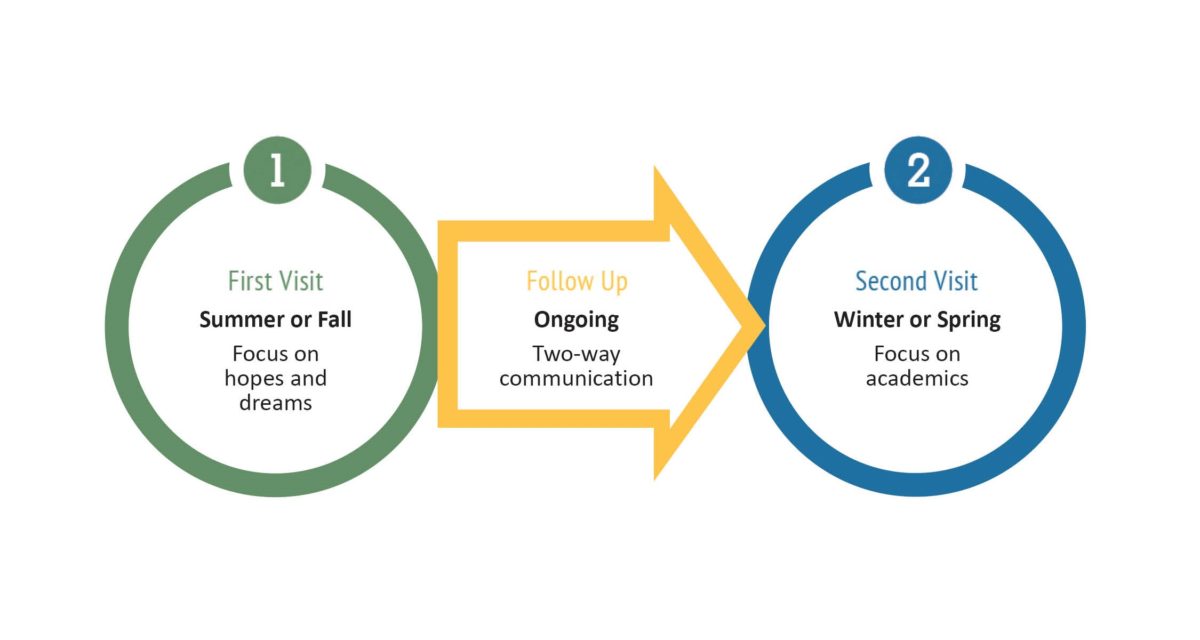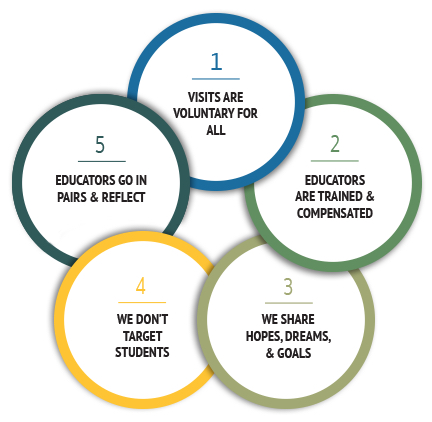The Parent Teacher Home Visit model was developed by Parent Teacher Home Visits, a nonprofit organization that works with public schools and other partners across the United States to support relationship-building home visits between educators and families. While other home visit models focus on the early childhood years, emphasize academic or behavioral issues, or provide social services, such as advice on childhood health and nutrition, the Parent Teacher Home Visit model can be used during any stage of child and youth development, and the primary goal is to build trusting, mutually supportive relationships between educators and families that will positively impact a child’s education.
“The Parent Teacher Home Visit model developed from an understanding that family engagement is critical to student success, and yet complex barriers often stand in the way of meaningful partnerships between educators and families. In communities where educators and families differ by race, culture, and/or class, educators may have little knowledge of the communities where they teach, including historic racism and poverty. They may also be unaware of their own automatic and unconscious biases that lead to disconnects and missed opportunities in teaching their students….
Mindset Shifts and Parent Teacher Home Visits, RTI International (Study I of a National Evaluation of Parent Teacher Home Visits 2017–2018)
Decades of research shows that students of color and those from low-income households are often treated differently from White and middle- and upper-class students in ways that have a negative impact on their school experience and learning. Although PTHV did not start as a program explicitly designed to reduce implicit biases in school communities, after close to two decades of practice, leaders of the model believe it does counteract these biases and that bridging divides as a result of race, culture, language, and socioeconomic status is an essential component of the program’s impact.”
Parent Teacher Home Visits originated in a low-income Sacramento neighborhood in 1998. A group of parents used the principles of community organizing to develop programs intended to build greater trust and accountability between parents and teachers. One of the foundational strategies was a voluntary home visit. In an unprecedented collaboration at the time, the school district, the local teachers union, and Sacramento ACT, a community-organizing group, worked together to pilot the first home visits. Since that time, hundreds of communities and school systems in more than two-dozen states have implemented the model.
The Parent Teacher Home Visit model has been the subject of several research studies and formal evaluations that have connected home visits to a variety of benefits for students, families, and teachers, including:
- Improved educational outcomes for students, such as higher student-attendance rates, increased literacy and reading comprehension, and greater engagement and motivation in the classroom.
- Adoption of more personalized and culturally responsive instructional strategies by educators, and more positive instructional interactions between students and teachers.
- Stronger home-school relationships, including families reporting increased trust in teachers and greater confidence reaching out to educators.
- Positive changes in family perceptions of their child’s school and teachers, and a reduction in negative assumptions or group stereotyping of students and families by educators.
- A more informed understanding of the causes of student behavioral issues, and a reduction in punitive disciplinary practices in the classroom.
The Parent Teacher Home Visit Model
According to Parent Teacher Home Visits, the home-visit model is designed to “connect the expertise of the family on their child with the classroom expertise of the teachers.” The home visits are not unplanned drop-ins, but scheduled appointments that are coordinated between willing colleagues—teachers and families—in a setting outside of the school. While a student’s home provides unique opportunities for learning about the family and a student’s home life, teachers may also meet with families in a public location—such as a library, park, or coffee shop—if it is more convenient or if the families request an outside-of-the-home location.

Schools typically announce a home-visit program to parents and let them know that their child’s teacher will initiate communication to describe the home-visit process, extend an invitation, and determine a family’s receptivity to a visit. If a family accepts the invitation, the home visits are conducted in teams of two—the child’s teacher and a trusted colleague (in most cases, a fellow teacher). The initial visit can take place at any time during the year, but the first is ideally conducted at the outset of a new school year during either the summer or fall.
Regular communication between the teacher and families continues after the first home visit using a communication method that works for both parties, whether it’s through in-person conversations or emails, texts, or phone calls. Over the course of the school year, teachers apply what they learned about their students to the instructional process, and families usually become more involved in school activities and in their children’s learning progress and coursework. A second visit is then conducted in late winter or spring, which focuses on academic issues, but with reference to the initial home visit conversation and to the mutual understanding that’s been developed since then.

The Five Non-Negotiable Core Practices
The Parent Teacher Home Visit model is routinely adapted and customized across the United States to meet the needs of teachers and families in a given community, but all home visit programs using the model follow these five non-negotiable core practices:
1. Visits are always voluntary for educators and families, and they are arranged in advance.
Home visits are never mandatory: all participants must agree to the visit. Because home visits are a choice, not a contractual or policy requirement, participating teachers and families need to be personally motivated to conduct the visit. In many cases, however, teachers and families who are initially reluctant to participate in a home visit will often change their minds once they hear about the benefits that home visits have had on other teachers and families.
2. Teachers are trained to conduct home visits, and they are compensated for visits that occur outside their normal school day.
Parent Teacher Home Visits provides training for educators before the launch of a local program, which addresses topics such as the research supporting the model; best practices for coordination and logistics; skill-building and practice sessions for engaging families; overcoming common barriers (e.g., funding, time, fears); cultural sensitivity and cross-cultural connection; and applying insights and lessons from home visits to the instructional process. Once a program is more established, train-the-trainer workshops may be provided to local educators. Compensation for participating educators typically comes from one of three sources: district funds (including Title I funding), foundation grants (from either local and national philanthropies), and union funds (including funding from national, state, or local teachers associations). The Parent Teacher Home Visits provides guidance on how home-visit programs are commonly funded.
3. The first visit focuses on relationship-building: teachers and families discuss hopes, dreams, aspirations, and goals.
While other home visit models focus on academics, student performance, or behavioral issues, Parent Teacher Home Visits has found that such interactions can reinforce potentially problematic power dynamics, such as families experiencing anxiety about being visited by an “authority figure” or feeling intimidated by the use of academic language they may not understand. For this reason, the initial home visit is focused entirely on relationship-building between educators and families, and the discussions address positive and affirming topics such as the family’s hopes and aspirations for their child, the child’s talents and learning strengths, or how the teacher and parents can work together to support the child’s development and educational growth.
4. There is no targeting of specific students, families, or groups: teachers either visit all of the school’s families, or a diverse cross-section of families, to avoid potential stigma.
By not targeting specific students, families, or groups, districts and schools can avoid negative perceptions of home visits. For example, if a school decides that home visits will only be conducted with families who live in a certain neighborhood or with the parents of students who are struggling academically, people are more likely to assume that visits are intended to address “problems,” not build stronger relationships, and other families may, therefore, be less motivated to participate in a visit.
5. Educators always conduct visits in pairs, and after the visit they reflect on the experience with their partner.
Pairing teachers helps to create a safer environment for both teachers and families, and it also gives visiting teachers someone who can help them reflect on the interaction and how it might be applied in the classroom.
Acknowledgments
Organizing Engagement thanks Gina Martinez-Keddy for her contributions to improving this introduction, and Parent Teacher Home Visits for permission to republish images from their website and publications.
Creative Commons

This work by Organizing Engagement is licensed under a Creative Commons Attribution-NonCommercial-ShareAlike 4.0 International License. When excerpting, adapting, or republishing content from this resource, users should cite the source texts and confirm that all quotations and excerpts are accurately presented.